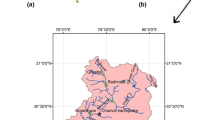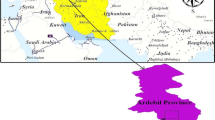Abstract
Earthquake-triggered landslides have aroused widespread attention because of their tremendous ability to harm people’s lives and properties. The best way to avoid and mitigate their damage is to develop landslide hazard maps and make them available to the public in advance of an earthquake. Future construction can then be built according to the level of hazard and existing structures can be retrofit as necessary. During recent years various approaches have been made to develop landslide hazard maps using statistical analysis or physical models. However, these methods have limitations. This study introduces a new GIS-based approach, using the contributing weight model, to evaluate the hazard of seismically-induced landslides. In this study, the city and surrounding area of Dujiangyan was selected as the research area because of its moderate-high seismic activity. The parameters incorporated into the model that related to the probability of landslide occurrence were: slope gradient, slope aspect, geomorphology, lithology, base level, surface roughness, earthquake intensity, fault proximity, drainage proximity, and road proximity. The parameters were converted into raster data format with a resolution of 25×25m2 pixels. Analysis of the GIS correlations shows that the highest earthquake-induced landslide hazard areas are mainly in the hills and in some of the moderately steep mountainous areas of central Dujiangyan. The highest hazard zone covers an area of 11.1% of the study area, and the density distribution of seismically-induced landslides was 3.025/km2 from the 2008 Wenchuan earthquake. The moderately hazardous areas are mainly distributed within the moderately steep mountainous regions of the northern and southeastern parts of the study area and the hills of the northeastern part; covering 32.0% of the study area and with a density distribution of 2.123/km2 resulting from the Wenchuan earthquake. The lowest hazard areas are mainly distributed in the topographically flat plain in the northeastern part and some of the relatively gently slopes in the moderately steep mountainous areas of the northern part of Dujiangyan and the surrounding area. The lowest hazard areas cover 56.9% of the study area and exhibited landslide densities of 0.941/km2 and less from the Wenchuan earthquake. The quality of the hazard map was validated using a comparison with the distribution of landslides that were cataloged as occurring from the Wenchuan earthquake. 43.1% of the study area consists of high and moderate hazardous zones, and these regions include 83.5% of landslides caused by the Wenchuan earthquake. The successful analysis shows that the contributing weight model can be effective for earthquake-triggered landslide hazard appraisal. The model’s results can provide the basis for risk management and regional planning is.
Similar content being viewed by others
References
Ayalew L., Yamagishi H., Ugawa N. 2004. Landslide Susceptibility Mapping Using GIS-based Weighted Linear Combination, the Case in Tsugawa Area of Agano River, Niigata Prefecture, Japan. Landslides 1:73–81.
Capolongo D., Refice A., Mankelow J. 2002. Evaluation Earthquake-triggered Landslide Hazard at the Basin Scale through GIS in Upper Sele River Valley. Surveys in Geophysics 23: 595–625.
Carro M., De Amicis M., Luzi L., Marzorati S. 2000. The Application of Predictive Modeling Techniques to Landslides Induced by Earthquake: the Case Study of the 26 September 1997 Umbria-Marche Earthquake (Italy). Engineering Geology 69: 139–159.
Chau K.T., Sze Y.L., Fung M.L. et al. 2004. Landslide Hazard Analysis for Hong Kong Using Landslide Inventory and GIS. Computers & Geosciences 30: 429–443.
China Earthquake Administration. 2008. Earthquake Intensity Zoning Map of China (1:1000000) Published by State Bureau of Surveying and Mapping.
Hudson J.A. 1992. Rock Engineering Systems: Theory & Practice. High Plains Press (JAH), Chichester.
Jibson R.W., Harp E.L., Michael J.A. 2000. A Method for Producing Digital Probabilistic Seismic Landslide Hazard Maps. Engineering Geology 58: 271–289.
Keefer, D.K. 1984. Landslides Caused by Earthquakes. Geological Society of America Bulletin 95: 406–421.
Koppula S.D. 1984. Pseudo-static Analysis of Clay Slopes Subjected to Earth-quakes. Geotechnique 34(1): 71–79.
Lee C.T., Huang C.C., Lee J.F. et al. 2008. Statistical Approach to Earthquake-induced Landslide Susceptibility. Engineering Geology 100: 43–58.
Lee S., Talib J.A. 2005. Probabilistic Landslide Susceptibility and Factor Effect Analysis. Environmental Geology 47: 982–990.
Luzi L., Pergalani F. 1996. Applications of Statistical and GIS Techniques to Slope Instability Zonation (1:50000 Fabriano Geological Map Sheet). Soil Dynamics and Earthquake Engineering 15(2): 83–94.
Miles S.B., Ho C.L. 1999. Rigorous Landslide Hazard Zonation Using Newmark’s Method and Stochastic Ground Motion Simulation. Soil Dynamics and Earthquake Engineering 18: 305–323.
Mirco Galli, Francesca Ardizzone, Mauro Cardinali et al. 2008. Comparing Landslide Inventory Maps. Geomorphology 94: 268–289.
Nefeslioglu H.A., Gokceoglu C., Sonmez H. 2008. An Assessment of the Use of Logistic Regression and Artificial Neural Networks with Different Sampling Strategies for the Preparation of Landslide Susceptibility Maps. Engineering Geology 97: 171–191.
Newmark N.M. 1965. Effects of Earthquakes on Dams and Embankments. Geotechnique 15(2): 139–160.
YIN Yaoping. 2009. Features of Landslides Triggered by the Wenchuan Earthquake. Journal of Engineering Geology 17(1): 29–38. (In Chinese)
PENG W.F., WANG C.L., CHEN S.T. et al. 2009. A Seismic Landslide Hazard Analysis with Topographic Effect, a Case Study in the 99 Peaks Region, Central Taiwan. Environmental Geology 57: 537–549.
QIAO Jianping, WU Caiyan, TIAN Hongling. 2004. Contribution Rate Research of Stratum to Landslide Growth of Yanyang-Wushan Segment in Three Gorges Reservoir Region. Chinese Journal of Rock Mechanics and Engineering 23(17): 2920–2924. (In Chinese)
QIAO Jianping, SHI Lili, WANG Meng. 2008. Landslide Risk Zoning Based on the Contributing Weight Stack Method. Geological Bulletin of China 27(11): 1787–1794. (In Chinese)
Refice A., Capolongo D. 2002. Probabilistic Modeling of Uncertainties in Earthquake-induced Landslide Hazard Assessment. Computers & Geosciences 28(6): 735–749.
Sichuan Geology Bureau. 1975. Geological Map of the People’s Republic of China (1:200,000) Published by China Geological Map Printing Plant.
TANG Chuan, ZHU Jing, ZHANG Xiangrui. 2001. GIS Based Earthquake Triggered Landslide Hazard Prediction. Journal of Seismological research 24(1): 73–81. (In Chinese)
TANG Chuan, ZHU Jing, LIANG Jingtao. 2009. Emergency Assessment of Seismic Landslide Susceptibility: A Case Study of the 2008 Wenchuan Earthquake Affected Area. Earthquake Engineering and Engineering Vibration 8(2): 207–217. (In Chinese)
WANG Huabin, Sassa Kyoji. 2007. Probabilistic Modeling of Seismically Triggered Landslides Using Monte Carlo Simulations. Rock and Soil Mechanics 28(12): 2565–2568. (In Chinese)
WANG Meng, QIAO Jianping, WU Caiyan. 2008. Regional Landslide Danger Assessment Based on GIS and the Root Factor Contributing Weight Model: a Case Study of the Wanzhou District, Chongqing. Geological Bulletin of China 27(11): 1802–1809. (In Chinese)
WANG Yaqiang, WANG Lanmin, ZHANG Xiaoye. 2004. GIS Based Seismic Landslide Zonation of the Loess Plateau. Scientia Geographica Sinica 24(2): 171–176. (In Chinese)
Author information
Authors and Affiliations
Corresponding author
Rights and permissions
About this article
Cite this article
Wang, M., Qiao, J. & He, S. GIS-based earthquake-triggered landslide hazard zoning using contributing weight model. J. Mt. Sci. 7, 339–352 (2010). https://doi.org/10.1007/s11629-010-2054-7
Received:
Accepted:
Published:
Issue Date:
DOI: https://doi.org/10.1007/s11629-010-2054-7




